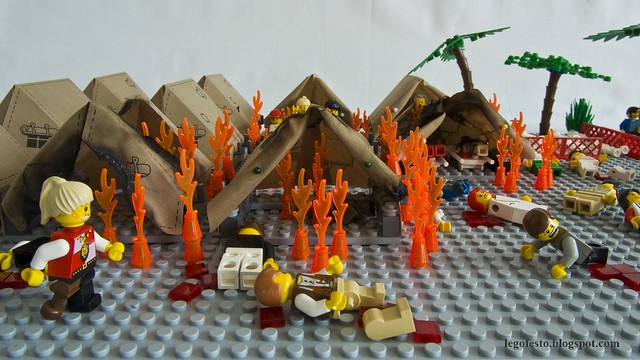Category: exposure
Video: ‘Brands are scared of these organisations’
What’s the role of labour rights NGOs in mediating relationships between brands, workers and governments? How do they make a difference to the lives and working conditions of the people who make our things? In this ‘Labour Behind the Label’ video, a labour union president from Bangladesh visiting the UK provides some answers…
Video: how pig parts make the world turn.
We love the work of Dutch artist Christien Meindertsma, and have drawn on her work to explain what the ‘follow the thing’ approach is all about, and how to do it well on our Classroom Resources page. We were reminded of her work today in a seminar in the Exeter Geography series by Ray Chan called “Capitalist pigs: politics of meat production and animal diseases in China.” We’re posting her 2010 TED talk today because it’s awesome. Enjoy!
I think that, in order to take better care of what’s behind our products — so, the livestock, the crops, the plants, the non-renewable materials, but also the people that produce these products — the first step would actually be to know that they are there.
Christian Meindertsma 2010 | TED Talk
How Guerrilla Projection can contribute to the Fashion Revolution: TED talk from Ismael Ferdous
It’s Fashion Revolution week this week. Today is the fourth anniversary of the deadly Rana Plaza collapse in Savar, Bangladesh. We’ve been working closely with Fashion Revolution almost from the start, our CEO Ian being a member of its Global Coordination Team. followthethings.com brings to Fashion Revolution a keen interest in cultural activism, its creation, discussion and impacts, This week we will be sharing each day a form of cultural activism that has made significant contributions to the movement.
Today’s post shows how photographs from the Rana Plaza site in the hours and days after the collapse were used to engage consumers and shame brands and retailers who refused to acknowledge that their clothes were being made there at the time. In this 2014 TED talk, Bangladeshi documentary photographer Ismael Ferdous talks about those he took on the day and what he did with them when he took them to New York. Guerrilla Projection is the activist tactic. This is moving, inspiring, troubling work.
Further reading
Samantha Corbin & Mark Read (2012) Tactic: Guerilla Projection. in Andrew Boyd (comp.) Beutiful trouble: a toolbox for revolution. New York: O/R, 52-53
Hannah Harris Green (2014) Photographer Ismail Ferdous On Documenting the Rana Plaza Factory Collapse. The Aerogram 15 May
MSc Napoli Shipwreck: 10 years on
 In January 2007, the container ship MSC Napoli was run aground in rough seas off the Jurassic Coast World Heritage Site in South West England. The unfolding drama of oil spillage, containers washing up on shore and their contents being salvaged near the village of Branscombe was international news. The wreck and its aftermaths was also researched in incredible detail by a well established local history group called the Branscombe Project whose members produced and exhibited original art work in response to it. Much has been written by journalists and academics about the Napoli, and artists (notably Melanie Jackson) have drawn it into their work. But it’s the inside story that emerges from this local research is perhaps the most interesting. At the end of her often-given talk, Barbara Farquharson – formerly an academic archaeologist and anthropologist and member of the Branscombe Project – has said that:
In January 2007, the container ship MSC Napoli was run aground in rough seas off the Jurassic Coast World Heritage Site in South West England. The unfolding drama of oil spillage, containers washing up on shore and their contents being salvaged near the village of Branscombe was international news. The wreck and its aftermaths was also researched in incredible detail by a well established local history group called the Branscombe Project whose members produced and exhibited original art work in response to it. Much has been written by journalists and academics about the Napoli, and artists (notably Melanie Jackson) have drawn it into their work. But it’s the inside story that emerges from this local research is perhaps the most interesting. At the end of her often-given talk, Barbara Farquharson – formerly an academic archaeologist and anthropologist and member of the Branscombe Project – has said that:
“When you think about it, the creation of World Heritage Sites are part of a global phenomenon involving the creation of iconic places that are both physical and cultural. So in a curious way the beaching of the Napoli hits the cross-wire between global cultural and environmental and economic and political issues” (Farquharson 2009, np).
The Napoli wreck is a brilliant insight into the geographies of material culture, the out of sight geographies of trade, and ways in which art and social science can make sense of its complexities. So the Napoli at Branscombe is worth revisiting for anyone who’s fascinated by these issues. We end with a reading list:
Continue reading
Follow the… Fairtrade Fortnight 2017
‘Would people still love a bargain if we bought these issues closer to home?’
‘Money is the journey we send it on.’
It’s fairtrade fortnight, the time of year when companies and NGOs make the relations and responsibilities between the producers and consumers of everyday things mainstream news. In this post we highlight two contrasting videos in which these relations are a) brought close to home through the delivery of food and b) stretched out through investing money (perhaps the most fascinating commodity) in an ethical ISA. Watch and discuss…
Follow the produce: the home delivery service they weren’t expecting
Follow the money: the most rewarding cash ISA in the world
New on followthethings.com: the 2 Euro T-shirt: a social experiment
It’s Fashion Revolution Week this week. Last year’s headline, viral #whomademyclothes smash came from Germany. A vending machine apparently dispensing t-shirts for only 2 Euros in a Berlin square. If you put your money in, you had to watch a video showing the sweatshop conditions in which they were made. Twenty seconds in, you were presented with an option to buy the t-shirt or donate your 2 Euros. You were also filmed. With your permission, your reactions were included in a short film that was posted on YouTube on 23 April 2015. To date, over 7 million people will have seen your reactions, the expressions on your face, and joined the often heated, occasionally funny and carefully reasoned conversation in the comments below, and elsewhere online.
At followthethings.com, we turn the thousands of comments all over the internet into a digested read, a single conversation. Reading this you might get a sense of how successful this experiment was, and what made the video go viral. You might also think what you might have added to the conversation. What is the experiment showing? What’s it not showing? See what you think. Here.
Highlights from the conversation: Continue reading
Fashion Revolution call for papers at RGS(IBG) annual conference
We’re involved in running a session at the Royal Geographical Society (Institute of British Geography) annual conference this summer whose aim is to bring academic fashion experts into dialogue with the Fashion Revolution movement. We’re asking how fashion research can contribute to what is becoming a worldwide movement for a more ethical / sustainable fashion industry in the wake of the Rana Plaza factory collapse in April 2013. We’re looking for academic research from any discipline that can contribute to Fashion Revolution’s five year planning. Here’s what we’re doing. Please get in touch with Ian, Lousie and/or Alex to discuss any ideas. The deadline for abstracts is Friday 12th February.
– Call for papers –
Scholar activism and the Fashion Revolution: ‘who made my clothes?’

Abstract
The collapse of the Rana Plaza factory complex on April 24th 2013, which crushed to death over 1,000 people making clothes for Western brands, was a final straw, a call to arms, for significant change in the fashion industry. Since then, tens of thousands of people have taken to social media, to the streets, to their schools and halls of government to uncover the lives hidden in the clothes we wear. Businesses, consumers, governments, academics, NGOS and others working towards a safer, cleaner and more just future for the fashion industry have been galvanised.
Political LEGO: an interview with Legofesto
We re-create scenes from the trade justice documentaries, art and activist work in LEGO. We photograph them, put them online and embed them on our site’s pages. You can see what we’ve done here. This work was inspired by LEGO scenes from the ‘War on Terror’ produced by a person calling herself Legofesto. We read interviews with and articles about her that were published in 2009, but hadn’t found anything since. This year, after teaching Political LEGO on the MRes Critical Human Geographies at Exeter University, one student – Julia Zielke – emailed Legofesto to interview her for an essay. What questions hadn’t been asked in those 2009 pieces? What had Legofesto been doing since then? Can we expect any new Legofesto work? This is what she said… Continue reading
Guest blog | Hannah asks her students ‘Who are you wearing?’
A couple of weeks ago, we attended the Geographical Association (GA) conference in Manchester. This is a conference for geography teachers, student geography teachers and the people who train them. We talked to many who taught their students the geographies of trade through researching their own clothes. We went to a talk where Hannah Campion, a newly qualified teacher, explained how she sparked her students’ curiosity about these geographies using some of our teaching resources. With the second anniversary of the Rana Plaza collapse only a few days away, we are publishing what she said…
A £4 t-shirt
My name is Hannah Campion. I am an NQT at The National Church of England Academy, Nottinghamshire. My fascination around the Geography of my ‘stuff’ developed from undergraduate study of commodity chains, commodity fetishism and Cook’s (2004) ‘follow the thing’ approach at the University of Nottingham. An assignment during my teacher training course on ‘Fantastic Geographies’ gave me the opportunity to bring this controversial issue into the classroom, to enable pupils to investigate and to develop a curiosity around the lives of our everyday commodities. The initial scheme is a 5 lesson sequence unveiling and unpicking the life of a plain white £4 t-shirt from production through to consumption. In 2014, I was asked to display my work at the Geographical Association conference in Guildford as part of the Ideas Zone exhibition. Since then, I have written an article for Teaching Geography (Campion 2015) and presented a Teacher-to-Teacher session at this year’s GA conference entitled ‘Behind the seams: global connections in the classroom (KS3)’.
Everything is (not) awesome: Greenpeace, Shell & Lego activism.
Greenpeace & Lego
Greenpeace want Lego to end its links with Shell, and are currently campaigning through the medium of imaginative Lego re-creation. This video is one of a number of examples, whose aim is to encourage people to sign this petition. In the wake of the hugely successful Lego Movie (whose stars make a cameo appearance) this campaign is becoming perhaps the most lavish and high-profile example of Lego activism to date.
followthethings.com & Lego
On a much smaller budget, we’ve been making, photographing and posting online re-creations in Lego of (imagined) scenes from trade justice films, art and activism for a while now. See, for example, our recreations from and around the BBC Panorama documentary ‘Primark on the rack’. Continue reading


